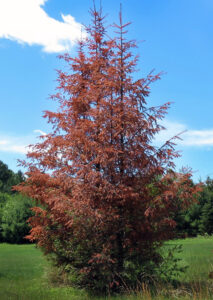Linda Williams, DNR Forest Health Specialist, Woodruff
Linda.Williams@wisconsin.gov or 920-360-0665

Scattered balsam fir trees in the Northwoods have suddenly turned brown and red this spring. / Photo Credit: Linda Williams, Wisconsin DNR
Scattered balsam fir trees in some areas of northern Wisconsin have suddenly turned rusty red to brown and are dying. These trees are not being impacted by spruce budworm and typically die with a full complement of needles.
The symptoms resemble what was observed in 2018 and 2020. So far, the number of trees being reported is smaller than what was seen in 2018 or 2020. Reports are still coming in, but they seem to be concentrated in northern areas of the state where we had extensive snowfall in late winter.
Much the same as in 2018 and 2020, balsam fir of all sizes have been impacted and trees that have suddenly died can be found next to other trees that are green with normal growth rates. Dead trees can be completely dead, or the top half to two-thirds of the tree may die.
No pathogens or pests that could have caused mortality have been observed in affected trees, although bark beetles are occasionally seen attacking the dying trees. On trees in which the top is dead but the lower branches are still alive, there are no clear margins between live and dead portions that would indicate a fungal canker.
In 2018 and 2020, the mortality was attributed to dramatic swings in weather during late winter and early spring, and it is suspected that this year is similar. From April 10-15, 2023, some areas of northern Wisconsin had several feet of snow on the ground when temperatures first hit the 70s during those dates. With warm temperatures and sunny days, conifers were losing water from their needles; but with deep snow still on the ground, the roots were not able to replenish that water.
Additionally, after a week of very warm temperatures in mid-April, much of the Northwoods experienced a low temperature in the teens on April 26, which may have been too much of a shock for some trees.
What makes one tree more susceptible than another is still unknown with these mortality events. Balsam fir that suddenly died this spring don’t seem to pose a risk to other nearby trees. Trees could be removed, but no special handling of the wood is required.
Watch for more information later in the season as additional locations of mortality are reported and more information is collected.
